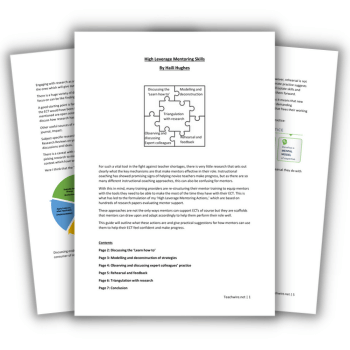Coaching models – Types, benefits and pitfalls for schools

We take a look at coaching in schools, exploring best practice and things to steer clear of…

- by Teachwire
- Classroom expertise and free resources for teachers

Learn about the best coaching models for teachers and see how other schools have put them into action…
Anthony David presents an overview of coaching in relation to education settings, looking at how to do it well – and what to avoid…
Using coaching models in education can help you deliver a personalised and transformative form of professional development that contrasts sharply with traditional, one-size-fits-all training methods.
We’ve seen adaptations to coaching models over the years. Personally, I was trained on various coaching models, some quite different from others.
Before even attempting any coaching, it’s wise to consider first what coaching model you might want to access. I’ll start by breaking down the main styles I’ve encountered and look at what each has to offer.
Four coaching models for schools
Instructional coaching
This coaching model (more on this below) involves one-on-one coaching for teachers that focuses on teaching strategies and classroom management.
Coaches work directly with teachers in classrooms, observing and providing feedback based on actual teaching practices, with the goal of improving instructional methods to enhance student learning.
Cognitive coaching
Developed by Art Costa and Robert Garmston, this coaching model seeks to build autonomous, self-directed learners among teachers.
The focus here is on developing teachers’ cognitive processes, with the coach guiding teachers through a process of reflective questioning to enhance their metacognitive skills, decision-making and planning capabilities.
Peer coaching
This coaching model is less hierarchical model. It sees teachers coaching one another within a school. It’s built around notions of mutual respect and collaboration, and aims to facilitate the experience of shared professional growth.
Peer coaching can be particularly effective at fostering a supportive community atmosphere, where teachers learn from each other’s experiences and strengths.
This coaching model saw widespread adoption in Japan during the late 1990s. The London borough of Barnet implemented it, with some notable success, during the mid-2010s.
Transformational coaching
Based on theories developed by Elena Aguilar, this coaching model looks beyond the ‘mere’ enhancement of technical skill, to broader educational values and visions.
It’s a model of coaching that sets out to inspire teachers so that they can envisage new possibilities for themselves and their students, focusing on those emotional and psychological barriers that might be limiting growth.
Important considerations
Each of these distinct coaching models presents a range of growth opportunities. What all have in common is that their impact takes shape over time – the key differentiator between coaching and ‘one-shot’ professional development solutions.
Before applying such approaches in your own setting, however, there are some important areas to consider first.
The first of these is that trust forms the cornerstone of effective coaching. A successful coach must establish a safe and confidential environment, in which the coachee feels secure enough to openly share their personal thoughts and challenges.
You can best achieve this through consistent, respectful and honest communication, which will in turn lay the groundwork for a trusting relationship.
“Trust forms the cornerstone of effective coaching”
Another critical skill you’ll need is active listening. Coaches need to truly hear what the mentee is saying and understand not just the words, but also the emotions behind them.
This can require patience, attentiveness and the discipline to avoid rushing to judgement or offering premature advice.
For leaders, this can feel counterintuitive, but it’s essential. Take time to pause before you speak – the results can be powerful.
Open-ended questions
The asking of powerful, open-ended questions is a technique that drives the coaching process forward, whichever coaching model you’re using. It encourages coachees to reflect, explore and ultimately discover insights and solutions that resonate with their own personal experiences and aspirations.
This can not only aid in problem-solving, but also empower the coachee to take ownership of their development journey.
Equally, however, don’t just ask a question for the sake of it. Sometimes silence is the best question you can pose.
Self-reflection
Self-reflection allows coachees to assess their progress and confront their challenges. This facilitates a deeper understanding of their professional journey and personal growth.
This can then be complemented by the coach providing specific, timely and constructive feedback centred on behaviours and their impacts, rather than personal traits.
“Self-reflection allows coachees to assess their progress and confront their challenges”
Coaching model training
If you’re to be a successful coach, then appropriate training is essential. As with many new skills, my strong recommendation would be that once you’ve been trained (in whatever coaching model you’re going to use – which in itself can take time to identify), you should follow your ‘script’ as closely as possible during those initial sessions of coaching a colleague.
Once you’ve built up your experience, you can then afford to adjust the process.
Challenges and pitfalls
That said, you should always endeavour to maintain a sense of professionalism throughout the process that supports the growth of a relationship, without crossing boundaries into personal territory.
This includes being consistently punctual, prepared and respectful of the coachee’s time and efforts.
A good coach will also be sensitive to the value of using resources wisely. These can encompass personality assessments, feedback tools and relevant literature. All of these have the potential to enhance the coaching experience and provide valuable insights.
Celebrating subsequent achievements with the coachee will not only boost their morale, but also reinforce the value of their efforts and the coaching process itself.
Finally, it’s essential that a coach commits to ongoing learning by staying abreast of new coaching models and continuously refining their skills. This ensures that the coaching you provide remains both relevant and effective over time.
“It’s essential that a coach commits to ongoing learning”
As with any influential tool, coaching involves carefully negotiating a series of challenges and potential pitfalls to ensure that the process remains both positive and productive.
Guiding versus directing
At the heart of any successful coaching model sits the principle of guiding, rather than directing. A common misstep some coaches can make is to lapse into a consultancy role, providing direct solutions to problems.
This approach can undermine the fundamental aim of coaching. This is to foster independence and self-development among coachees, rather than creating a dependency on the coach for answers.
“At the heart of any successful coaching model sits the principle of guiding, rather than directing“
The maintenance of an open, non-judgmental stance is another cornerstone of effective coaching. Coachees are far more likely to engage openly and honestly in the coaching process if they don’t feel that they’re being judged.
Listening
As previously mentioned, listening plays a crucial role in whatever coaching model you choose – even more so than speaking. A coach who dominates conversations may inadvertently stifle a coachee’s ability to reflect deeply and articulate their thoughts. This hinders their path to self-discovery.
For that reason, it’s of paramount importance that confidentiality is observed when coaching. A breach of this trust can irreparably damage the coach-coachee relationship and deter future engagement.
Likewise, feedback should be timely, specific and constructive to facilitate actionable insights and growth.
I’ll conclude with one final point – which is to ensure that your colleague wants to be coached. The process cannot be forced onto someone if they’re not willing to be involved (even if you’re surprised, as I sometimes have been, by colleagues’ reluctance).
In such cases, you may just have to accept that some people find it very difficult to talk about themselves!
Anthony David is an executive headteacher.
Instructional coaching – school case study

Leyla Palmer of Windsor Academy Trust tells us why instructional coaching may well be the CPD delivery mechanism you’ve been looking for…
Schools across the country are often faced with the difficult challenge of ensuring that their teacher CPD is impactful. But what does impactful CPD look like?
With our long history as a provider of CPD, we’ve carried out a considerable amount of research in this area to try and answer that age-old question, and better understand what really makes for effective and meaningful CPD.
Closing the loop
We’re well aware of the difficulties school leaders will often grapple with when it comes to CPD. All too often, you’ll hear teachers remarking on how regular whole school CPD is often poorly aligned to their subject-specific and individual needs.
Most school leaders are conscious that this type of CPD often fails to close the loop in terms of teachers actually going away and implementing what they’ve ‘learnt’ in their own classrooms.
Instructional coaching is an approach that aims to address the issues often associated with traditional teacher CPD. It allows for a greater degree of individualised and subject-specific training.
“Instructional coaching is an approach that aims to address the issues often associated with traditional teacher CPD”
A core principle of instructional coaching is that trained coaches work individually with teachers to develop their expertise.
A coach will regularly drop in on a teacher’s lessons for around 10 to 15 minutes. They’ll identify a bite-sized area for improvement.
They will then consider what the ideal outcome for that teacher would look like, and identify this as the teacher’s ‘target performance’.
Through a subsequent conversation between coach and teacher, the teacher will then move from their current performance to the target performance by practising the identified classroom strategy. They’ll receive support and direction from the coach, in a process referred to as ‘deliberate practice’.
This allows teachers to close the knowing/doing gap. It enables them to overcome existing ingrained habits and adopt new behaviours. This closes the loop between theory and implementation.
Productive discussions
Instructional coaching seeks to impart contextual and pedagogical skills and knowledge to those teachers being coached based on where they’re currently at. This is rather than assuming a one-size fits-all model. This is frequently the case with generic, whole-school CPD approaches.
Everyone, from trainee teachers right up to highly experienced practitioners, can benefit from this form of coaching.
Trending
What’s important to note, however, is the approach the coach adopts will be specifically tailored to the skill level, experience and existing expertise of each respective teacher.
Generally speaking, coaches are more likely to adopt a more facilitative approach when working with experienced practitioners.
With junior and relatively inexperienced teachers, a more directive-based approach will be more effective. Allowing the resulting coaching conversations to fall somewhere between the two ends of this spectrum allows for input from teachers and more productive discussions.
“With junior and relatively inexperienced teachers, a more directive-based approach will be more effective”
Teachers thus retain opportunities to demonstrate autonomy and creativity. Meanwhile, coaches acknowledge and respect that teachers know their students and understand their specific classroom context.
Getting started
I was looking for an approach that could drive forward our teacher performance, while transforming our teachers’ and leaders’ thinking around how this might be achieved.
Having engaged with a great deal of research around instructional coaching from Dr Sam Sims and Steve Farndon, and having seen Jon Hutchinson (director of training and development at the Reach Foundation) present a talk on the topic during a Future Leaders conference, I wanted to explore how we might introduce instructional coaching at my school.
This led me to launch a pilot programme. This saw us share the vision and research around the initiative with other senior and middle leaders in order to gain buy-in.
The next step involved identifying and training a team of teachers to become expert coaches, as well as finding solutions to various practical and logistical complexities.
Where would we find the time to do this? What ongoing support could I provide the coaches with, and what resources would we need? Those were just some of the questions that needed addressing prior to the pilot’s launch.
‘Cringey, but vital’
In common with many of the coaches who took part in the pilot, I personally found the approach’s deliberate practice aspect to be the most challenging.
My first attempt at acting out a suggested strategy with a coachee ended up feeling really awkward at first.
That said, we have since received positive feedback on our instructional coaching pilot programme from the coaches and teachers involved, and observed a noticeable impact on teacher effectiveness in lessons.
This prompted us to scale up our instructional coaching approach from being simply school-wide, to one encompassing the entirety of our school trust. At the time of writing, I’ve just completed our first five months of implementation.
“My first attempt at acting out a suggested strategy with a coachee ended up feeling really awkward”
There were numerous considerations to make when doing this. One priority was to be aware of individual school contexts. For example, larger schools tend to require a staggered, term-by-term approach to one-to-one coaching, where weekly one-to-one sessions usually aren’t possible due to the sheer volume of coaches required.
Whole school, teacher deliberate practice was then built into staff meeting time, further developing the coaching culture. We also needed to ensure that we effectively trained our teams of coaches in each school before implementation.
To assist with the latter, we enlisted the support of Jon Hutchinson, who delivered three bespoke coaching training sessions for our coaches during the first term of implementation. As one coach put it, “The training on identifying action steps with the highest leverage has really helped me to focus on targets that really move practice forward.
“Deliberate practice is cringey, but it is vital We are now comfortable with it, and can see how it prepares us to do it for real. It means that we can approach different actions in the classroom with confidence.”
No silver bullet
School leaders leading the charge on this alternate approach to CPD across our schools have had to ensure their coaching pairings are well thought out.
It’s critical that these are built upon trusting relationships, where teachers feel safe to practice with their coach, without fear of judgement or any negative repercussions.
We’ve further found that pairing coaches with teachers who share their subject specialisms has allowed for greater subject specificity in the ensuing coaching conversations.
There’s no silver bullet for the complexities associated with teacher CPD, and I would stress that instructional coaching is definitely no ‘quick fix’, since it involves different challenges of its own.
To ensure it has a fighting chance of being effective, schools have to allocate sufficient time for the implementation process, and ultimately decide for themselves which elements of their prior CPD approach have to go in order for the new method to be successful.
“There’s no silver bullet for the complexities associated with teacher CPD”
Looking ahead, our next steps will involve refining our approaches to instructional coaching, and utilising feedback to inform our future practice.
We’re also in the process of designing a coaching programme for our professional services teams, and have high hopes for the impact this will subsequently have across our family of schools.
Leyla Palmer is head of professional learning and talent at Windsor Academy Trust; to find out more, visit windsoracademytrust.org.uk or follow @WinAcadTrust.
How to build a coaching culture in your school

We need to empower people to develop their own brilliant ways to address issues in our schools, and that’s where coaching comes in.
School staff can sometimes feel they have the weight of the world on their shoulders. However, there is no need to carry that burden alone.
Rather than trying to fix everything all at once, it is better to build a team of capable problem solvers who are always ready for the next set of challenges.
Anyone in a school can be a coach. A less experienced teacher could have a coaching conversation with a more experienced colleague; for example, to help them find ways to address day-to-day challenges such as how to help pupils collaborate on a project using technology, or how to teach a maths lesson outdoors.
However, getting to this point involves embedding coaching throughout a school, and that calls for a culture shift…
Solution-focused coaching steps
Take the example of a teacher who is experiencing low-level disruption in their Y5 class. If the teacher comes to you for help, your natural instinct might be to tell them what you would do in that situation and recommend they do the same.
Alternatively, you might be tempted to go to the classroom and talk to the children yourself. However, this won’t help the teacher find their own way to approach the issue next time.
“You might be tempted to go to the classroom and talk to the children yourself”
In a coaching culture, the first thing to do is listen – and empathise. Find out what the issue really is: are the children tired, distracted or disengaged?
Then you become a facilitator by asking your colleague what techniques they could use and how they could make the most of their own professional qualities to address the situation.
Example coaching steps
Here are some coaching steps for this scenario:
- Encourage the teacher to explore what the issues could be. Are the pupils really misbehaving or are there other factors making them play up?
- Focus on encouraging them to accept what is happening in the classroom when pupils behave in this way.
- Inspire the teacher to identify what they want to achieve by making a change. What is their aim?
- Ask, but don’t suggest, what steps they could consider taking to address the issue.
- Empower the teacher to think about their own set of skills and qualities, and how these can be used to help them to solve the problem.
- Challenge them to take ownership of the issue and encourage them to think of one or two new actions they could try, to see if it changes the pupils’ behaviour.
Coaching conversations
Coaching gives teachers the time and space to express their individual voices as professionals. That’s because it is not passive – coaching is not done to someone, it is done with them.
In a school with a coaching culture, these conversations become a part of everyday learning. A good coaching conversation will follow the 80:20 rule. The coach should keep a teacher in the ‘what’ part of the conversation for 80 per cent of the time.
This is when you encourage the teacher to fully explore what the issue is, accept what is happening as a result, and identify what they want to achieve.
“A good coaching conversation will follow the 80:20 rule”
For the remaining 20 per cent of the time, you focus on the ‘how’ part of the conversation, when the teacher talks about how they want to move forward.
At this point, the teacher should create one or two tangible, positive actions to address the issue.
Example coaching questions
It can be useful to have a set of coaching questions to give structure to the conversation, such as:
- Where are you now? This explores the teacher’s strengths and areas of development without overly focusing on or brushing over the negative.
- Where would you like to be? This question examines what the teacher wants their practice to look, feel or sound like next.
- What do you already do? This keeps the conversation positive by establishing what is working well and what they should keep doing.
- How could you be more effective? This is the point where the teacher considers their next steps and sets some well-defined goals.
Impact of coaching
Coaching can take a bit of getting used to at first. While training and mentoring focuses on imparting knowledge and demonstrating skills, coaching is more about encouraging people to change their behaviour and mindsets.
As a result, some teachers initially feel challenged by coaching. And yes, they are being challenged, but in a positive way.
“Coaching can take a bit of getting used to at first”
Ultimately what happens is people learn to self-coach. They ask themselves difficult questions and are always seeking out opportunities to improve, flourish and progress.
Paul Day, assistant headteacher at Royal Wootton Bassett Academy, says this about the impact of coaching in his school:
“The problem with many approaches to professional development is that they focus on what people are not so good at, and what they need to improve. Coaching, on the other hand, gives staff greater autonomy over their own development, and it encourages them to seek out opportunities to learn and grow.
“One of our teachers was having difficulties in the classroom and the leadership team were trying to find ways to offer support. But the real difference came when this teacher started her coaching journey.
“She became inspired to take ownership of her future, found her spark as a teacher and flourished. This teacher is now a head of department.”
Teacher retention
Schools urgently need to recruit and retain great talent, and the best teachers want to work in an environment where they can grow as professionals and make a genuine difference to their pupils’ lives.
Teachers will want to work in your school because it is a place where everyone thrives, and is empowered to succeed.
In fact, coaching comes naturally to people who work in schools. Good teachers are already supporting their pupils to tackle problems and figure out solutions for themselves.
Empowering teachers to use their own teaching style to overcome hurdles will help your school whatever the future brings.
Damian Mitchelmore is a former deputy head and managing director of OLEVI, a leading coaching organisation for schools.
Other coaching models
Successful coaching styles in other professional settings can include…
- Directive coaching: Provides specific guidance and immediate feedback that’s ideal for urgent skill development
- Non-directive coaching: Encourages self-discovery and solutions by asking open-ended questions, while fostering independence and critical thinking
- Collaborative coaching: Involves working alongside the coachee as a partner, facilitating mutual learning and joint problem-solving
- Holistic coaching: Focuses on the coachee’s overall development, integrating aspects of their professional and personal growth
- Transformational coaching: Aims to inspire significant changes in behaviour and mindset, and encourage coachees to transcend their current limitations
- Democratic coaching: Seeks input from the coachee to guide the coaching process, thus promoting engagement and empowerment
Even more coaching models
- GROW coaching: Guides individuals to set goals, explore the current reality, consider options and establish a way forward to achieve professional development
- CLEAR coaching: Focuses on creating clarity and insight through powerful questioning and active listening. CLEAR stands for Contract, Listen, Explore, Action, Review
- FUEL coaching: Ignites motivation and drive by tapping into individuals’ passions, strengths and values. FUEL stands for frame the conversation; understand the current state; explore the desired state; lay out a success plan
- STEPPA coaching: Employs a systematic approach of setting specific, measurable, achievable, relevant and time-bound goals
- Achieve coaching: A seven-step process built off the GROW coaching model, incorporating additional feedback loops with open-ended questions










